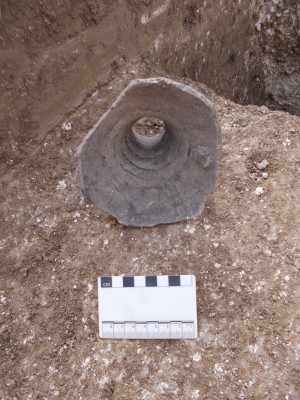I’ve been working on an archaeological evaluation down in Dorset recently and Trench No. 28 had some interesting features – 2 linear ditches, one at each end of the trench, and a possible pit just off centre of the trench. One of the linear ditches is pictured below, a rather fine example. The underlying geology is chalk.

The pit-like feature after excavation turned out to be a ‘Bell Pit’.

‘Bell Pits’ start out as pits that have been dug out to store grain and successive clearing events then give them their distinctive shape – narrow at the top and widening towards the base, when they are no longer of use they are backfilled. This particular pit was excavated to 1.20 metres below existing ground level, unfortunately due to Health & Safety constraints the excavation was terminated at this depth. Augering at the base proved the pit to be 2.20 mbgl revealing a basal layer c.100mm thickness of mottled red, purple and grey clay that had signs of reworking and is thought to be the original capping layer that once sealed the grain store. The fill material contained some good chunky pottery sherds mostly of Black Burnished Ware but also Samian and possibly New Forest Ware. Among the sherds was this rather nice jug with coil made neck and burnished bowl (possibly wheel thrown).



The existence of the bell pit and linear ditches might suggest that there was a settlement nearby. The finds seem to suggest Roman period date possibly 1st-2nd century AD.

